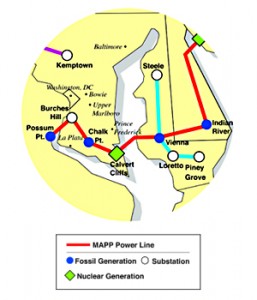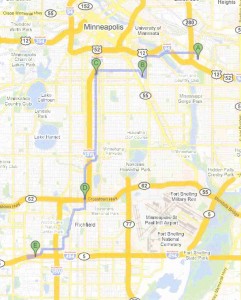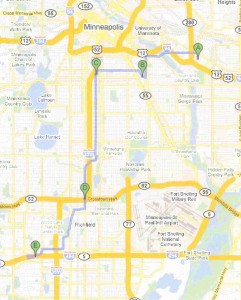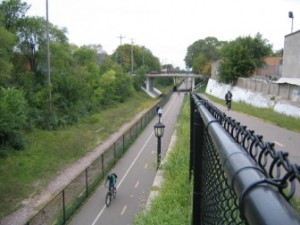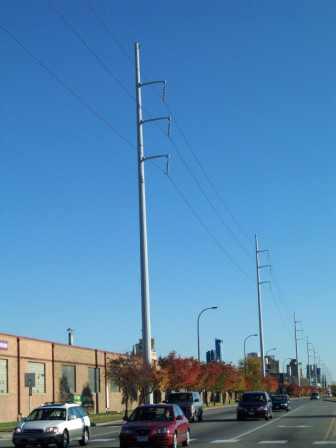Transmission – Mid-Atlantic Power Pathway
February 2nd, 2009
Delmarva Power has been hosting meetings about its proposed Mid-Atlantic Power Pathway. The next meeting is:
Wednesday, February 4 @ 6 p.m.
Millsboro Civic Center
322 Wilson Highway
This is an electrical superhighway through Delaware, the map makes that much clear.
What’s interesting is that Rep. Tom Carper seems to be taking an enlightened and informed position on this:
Today, there’s a long piece in the News Journal about it, with the above quote from Carper:
Power-line plan stirs environment fears
Bluewater Wind hails pathway for clean energy
Xcel transmission — Opposition anyone???
January 27th, 2009
Poor Xcel, getting picked on… a City of Minneapolis resolution to delay the route application for the Hiawatha Project transmission line, and a unanimous preference for undergrounding if it should be built. SNORT!
LET’S SEE THE SOUTH MINNEAPOLIS LOAD SERVING STUDY (which the Hiawatha Project is supposedly based on) and the SOUTH MINNEAPOLIS ELECTRIC RELIABILITY PROJECT STUDY which is shooting in a 345kV line from Hwy. 280 to the new Hiawatha substation… “100 MW need” my ass…
Here are 16 questions posed by Midtown Greenway to Xcel and 9 answers:
Piecing together studies found on line, here’s what I think Xcel is up to:
Take your transmission line and go home, Xcel…
Open House – Xcel’s Hiawatha Project
January 17th, 2009
Thursday afternoon and again in the evening, Xcel held an Open House for its proposed “Hiawatha Project,” transmission through Phillips.
What I learned:
From Pam Rasmussen: Conductor specs — 795 ACSS DOUBLE CIRCUIT and NOT bundled. But there’s not much impact on the capacity, it’s essentially the same. Here’s the conductor spec chart, where you can look up 795kCmil on the left and then go over to the right to 115kV — remember this is for 1 circuit, so for 2, double it — this is from the SW MN 345kV case:
From Dave Callahan: The area on Hiawatha where they’re looking at sticking a substation is North of Lake, on the East side of Hiawatha, where the northwest end of that Target complex abuts another group of buildings on Minnehaha backing up to Hiawatha. There’s no road access, and there’s been talk of extending the Midtown Greenway from a bit north through this area towards Lake Street. It sounded like Xcel had already had discussions of how to put a substation there and leave room for the Greenway expansion. As there’s no road, the easiest way I see to get there is to start at Cedar and head east on Hiawatha, tromp on it to get some lift and do an Evil Kinevil over Hiawatha and land there… otherwise, try walking from Minnehaha. It’s just to the right of the “A” below:
Recently, Xcel had announced that its preferred route is along the Midtown Greenway. In looking at routes, and digging through my files, I’d discovered the Metro Load Serving Study from 2001. That study says, about plans for South Minneapolis: Oh my, LOTS about South Minneapolis, I’m going to have to do a whole separate post on that. Manana…
At the July 24, 2008, NM-SPG meeting, there was this presentation, per the minutes:
7.1.4. South Minneapolis
Mr. Standing, XCEL, presented the South Minneapolis Electric Reliability Project (SMERP) study. Mr. Standing stated 4 options were studied. The preferred option includes a new 345 kV line in-service in approximately 2013-2020 from the New Hwy 280 345/115 kV substation to the New Hiawatha substation.
And from the 2007 Biennial Transmission Plan, we have this snippet that gives us a peek at their plans:
That section of the 2007 Biennial Transmission Plan is just too big. CLICK HERE and click on section 7.5 and scroll down to the 3rd and 4th to the last pages.
In that section of the 2007 Transmission Plan, it describes a “need” in South Minneapolis:
Are you paying attention? The “inadequacy” is in the 12.4kV distribution system. Or the “inadequacy” IS the 12.4kV distribution system. Also note that they are forecasting a load growth of 100MW over the next 10 years. Don’t forget these points.
When you take the plans that are out there for the taking, and sketch them out, here’s what it looks like (this is old news, but once more with feeling):
Xcel, when you’ve got an inadequacy with your 12.4kV distribution system, and power quality issues at some of the big electric users, why would you think that this big linked addition of transmission is the answer. How about trying a distribution upgrade — isn’t it long overdue? And underground that distribution while you’re at it!
Xcel’s Hiawatha Project sent to Committee
January 10th, 2009
Well this is interesting… to put it mildly… Xcel’s Hiawatha Project, transmission through Phillips, is in the news.
A move to “delay its application… until it provides a more thorough analysis of the need an alternatives” and that if line is “needed,” to bury it under 28th Street is deemed “trying to get the council to adopt a position without public hearings or notice?”
Hmmmmmmmmmmm…
Now Xcel claims the need for the Hiawatha Project is based on the “South Minneapolis Load Service Study,” but cannot or will not produce a copy of that study. They say it is not completed yet… Oh, and so you’re wanting this line for what????
And then I find that there’s also a “South Minneapolis Electric Reliability Project” where they want to run a 345kV line from Hwy. 280 to the new Hiawatha Project substation.
As discussed, but not quite yet formally proposed, Xcel’s Hiawatha Project would have a substation somewhere near 28th & Hiawatha, and the line would go east through Prestigious East Phillips to near the old Honeywell site near 35W.
Don’t forget, there are three meetings coming up, one held by the community, and two others by Xcel:
Community Forum on Xcel’s Hiawatha Project
Sponsored by the Phillips Community Energy Cooperative, the Greenway Coalition, and others
Monday, January 12, 2009
At Plaza Verde
1516 East Lake Street
6:30 p.m. to 8:30 p.m.
… and an Open House, another opportunity to dig into this project and find out what’s really going on:
Xcel Energy’s Public Open House on the Hiawatha Project
Thursday, January 15, 2009
At Plaza Verde, 1516 East Lake Street
Noon to 2:00 p.m.
and 5:00 p.m. to 7:00 p.m.
Search this site for “Hiawatha Project” for background information.
Minneapolis council diverts power-line issue
“We have a responsibility outside an empty room,” Council Member Lisa Goodman said.
Xcel’s Hiawatha Project – Forum & Open House
December 19th, 2008
Xcel’s Hiawatha Project is sitting there like the fart in the elevator, and I’m wondering what they’re doing in the back rooms of Minneapolis City Hall when we’re not looking.
Two events coming up in January:
Community Forum on Xcel’s Hiawatha Project
Sponsored by the Phillips Community Energy Cooperative, the Coalition, and others
Monday, January 12, 2009
At Plaza Verde
1516 East Lake Street
6:30 p.m. to 8:30 p.m.
… and an Open House, another opportunity to dig into this project and find out what’s really going on:
Xcel Energy’s Next Public Open House on the Hiawatha Project
Thursday, January 15, 2009
At Plaza Verde, 1516 East Lake Street
Noon to 2:00 p.m.
And 5:00 p.m. to 7:00 p.m.
CLICK HERE FOR XCEL’S HIAWATHA PROJECT SITE
Here’s something to make your head scratch… the project is based on a study of south Minneapolis, which they confirm on their site:
OK, so where is it? They won’t produce it! Local stakeholders have asked nicely, they even say “PLEASE?” and nope, no study. Contact Betty Mirzayi (betty.mirzayi[at]xcelenergy.com), Pam Rassmussen (pamela.jo.rasmussen[at]xcelenergy.com) and Paul Adelmann (paul.adelmann[at]xcelenergy.com) and ask them for a copy of the South Minneapolis study that’s the basis for the Hiawatha Project.
